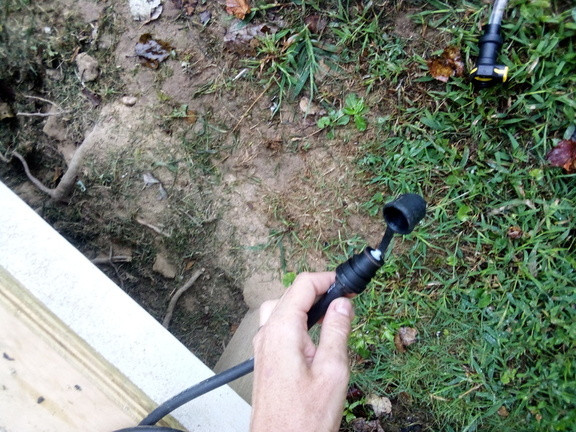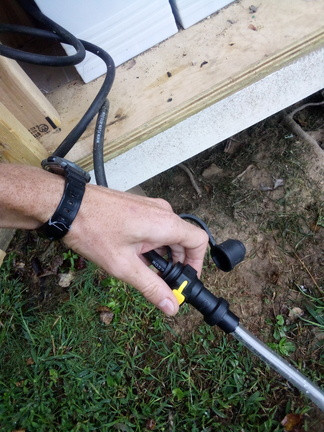House Systems
This page is still under construction...
Well Water
-
- Option 1: open the hose spigot on the side of the well house and let it run for a while. Sometimes you will see some reddish or brownish water come out. Even if it just runs clear, there may be sediment that is being cleaned out. There is a black flexible hose that connects from the bottom of the clear sediment filter bowl to the spigot. Using this spigot for general watering will help to continuously clean the sediment filter.
- Option 2: Inside the well house, turn the large blue valve perpendicular (sideways) to the pipe and turn the small blue valve to inline with the pipe (as shown below). This has the effect of bypassing the sediment filter and when you turn on the spigot on the outside of the well house, water then will flow backwards through the filter. So to complete this step, turn on the outside spigot (like option 1) and let it run for a while.
-
Well pump control box
-
- If the water has turned off completely, check to see if there is a red light on the Timer, indicating it tripped. Whenever the well pump is running, the green light blinks, which is normal. Reset the Timer by turning the Breaker to OFF (down) and back ON (up).
- There is a box inside the well house that contains a Breaker, NTC (soft-start), and Timer for the well pump:

- The Breaker (blue switch at the upper left) must be flipped up to provide power.
- At the upper-right, there is a Timer module (narrow white component with a green and a red light, on the right side of the screen with numbers). While the pump is running, the green light
is on.blinks. If the pump runs continuously for more than an hour, the red light also turns on, and the timer stops the pump. - The
isTimer acts as asafetysafety, to minimize water damage andreducewear on the pump, inthecasethere isa pipethatbreaks or water isleftflowingonuncontrolled. - Watering
long.the gardenIforyou're wateringgrass for a longtime, thattime can also causethisthe Timer to trip. Normally, if the water flow rate through the hose is slower than the flow rate of the well pump, then the pump will turn off periodically. Whenever the well pump turns off the Timer is reset, so the Timer only flips when the flow rate keeps the pump on continuously for an hour.The easiestEasiest way to reset the timer is to flip the Breaker to OFF (down), then ON (up).
- To change how long the Timer waits before turning off the pump, you can change the settings of the red dials.
Thistoo - The black coin-size disk in the middle of the box is an NTC or "Thermistor". This component is providing a soft-start to the pump motor. The NTC resists the flow of electric current when it's cold (when the motor is first starting) and then allow the flow with very little resistance when it gets hot (after the motor gets up to speed). Because of this, while the pump is running, the NTC will be too hot to touch. Because of the continual heating and cooling cycles, eventually the NTC will wear out and probably break in pieces. If this happens, there are spare NTCs in a small plastic bag at the bottom of the box.
-
Well specs
- Depths
- Bottom of the well is 120ft (from memory of what the driller guys told us)
- Water at about 5 gal/min is at about 35ft.
- Water at about 40+ gal/min is at 105ft.
- Pump is at about 100ft, 20ft above bottom (from memory of what installer told us, one of the same guys who ran the driller).
- It's likely that water fills up pretty high in the well, all the way up to around the 35ft mark.
- Power supply
- 4000W 240Vac inverter located on inside-right wall of the white "solar shed".
- Does not have an option to connection to grid power.
- Breaker in solar shed and also in the pump control box inside the well house.
- Pump
- 240Vac
- 1/2hp
- 2-wire
Battery Maintenance
- The solar panel arrays are connected to the Solar Array Charge Controller, which converts the voltage of the solar panels (typically around 100Vdc), to the voltage of the batteries (48Vdc). The Large Battery Array is eight 6V batteries (6 x 8 = 48) and the Small Battery Array is four 12V batteries (12 x 4 = 48).
- The batteries are fairly maintenance-free, but the Large Battery Array needs some distilled water added every few months (possibly every month when it's hot).
-
The Small Battery Array is 4 of the 8 batteries I initially bought from Walmart. The Small Battery Array is connected in parallel with the Large Battery Array (bought later from Crown Batteries). The small array helps the Well Pump Inverter with bursts of current drawn by the pump motor.
- There is a squeeze-pump system to replenish distilled water in the Large Battery Array.




- It's best to add water when the batteries are fully charged. This would probably be in the evening or after dark, after a sunny day.
- Use the squeeze bulb to pump distilled water until it becomes too hard to pump any more. There are float valves inside the watering system that shut off when each battery is full of water.
- Battery and power web-browser displayed graph
Grid/Solar Switch
- Most 120V circuits relocated to sub-panel
- Sub-panel is switched between solar and grid
- Main panel contains 240V circuits (except for well pump)
Ferrous iron removal system
-
- White tank in the crawl space
- Nightly reverse-rinse cycle
- Iron builds up in the filter media inside the tank, so it has to reverse the process and rinse out every night
- The black tube is the drain hose, and is fastened in the sump pump bucket. This way the reverse-rinse drains into the ground at the sump pump, and if it fills up too much, the sump pump will pump it out.
- The reverse-rinse cycle is currently set to happen every night at 1:00AM
Basement Water Removal
- Sump pump
- Baseboard drain
Door Bell
- Driveway sensors
- (CURRENTLY NOT WORKING! The sensor board had a resistor burn up...)









